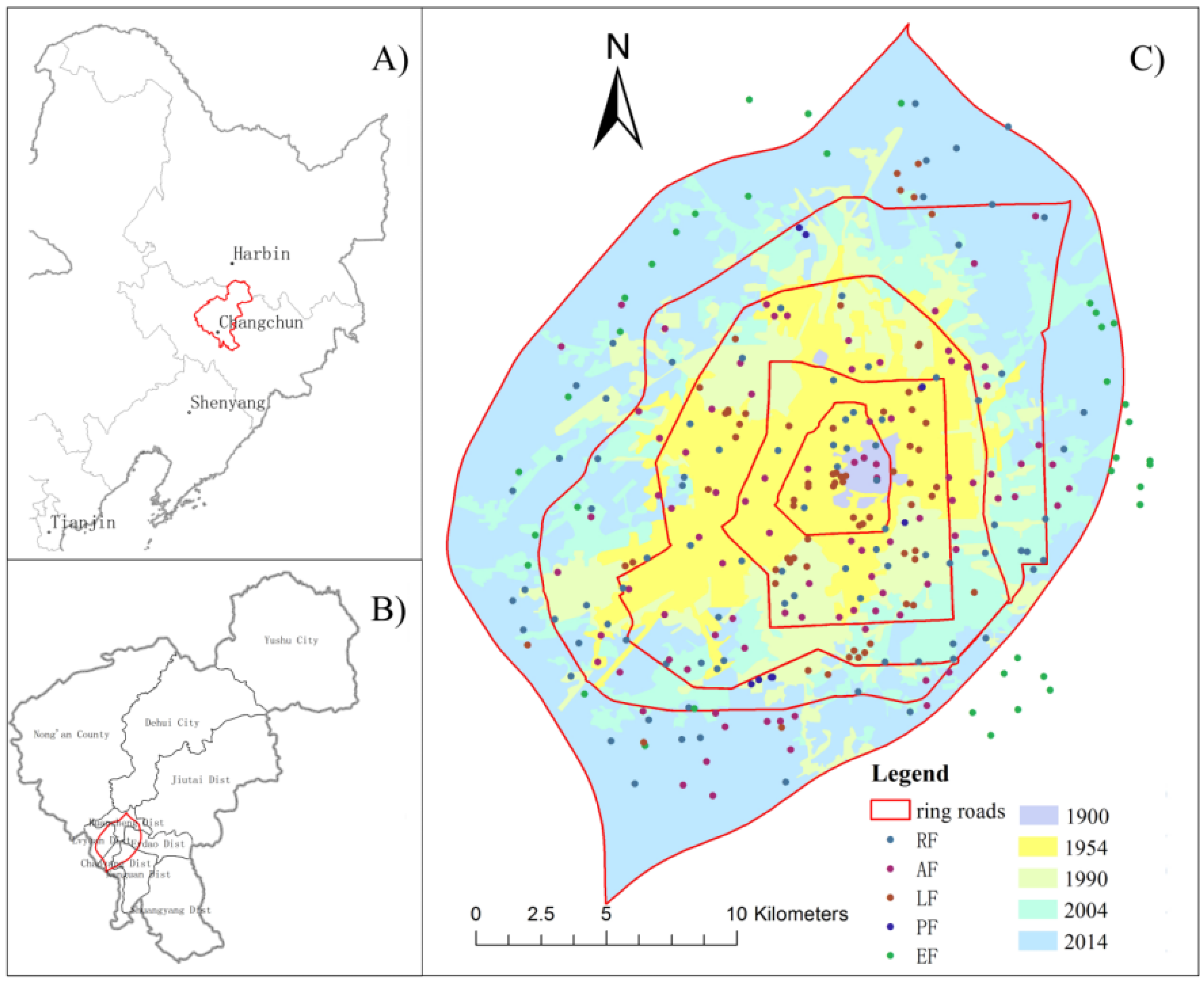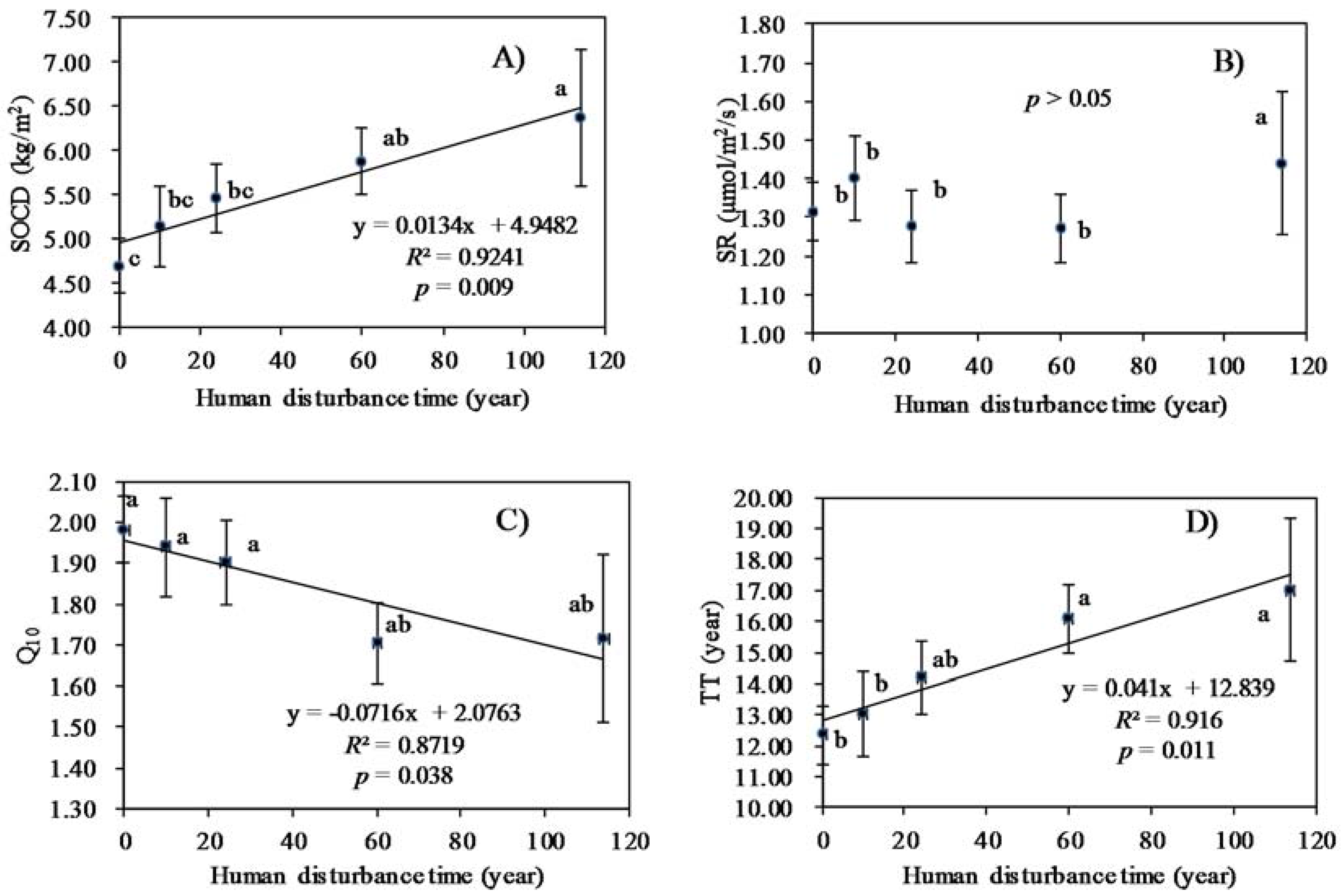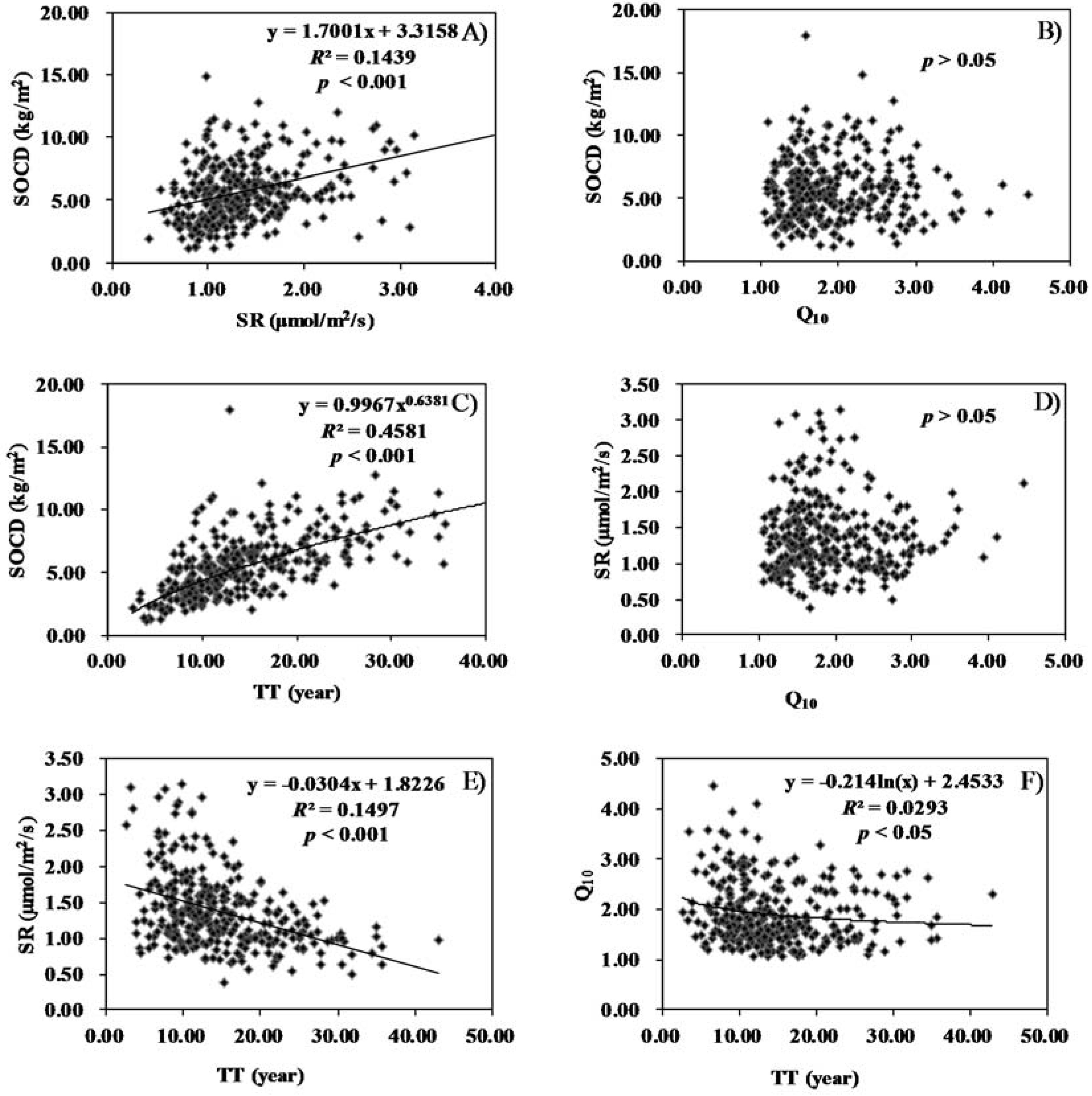Urbanization Drives SOC Accumulation, Its Temperature Stability and Turnover in Forests, Northeastern China
Abstract
:1. Introduction
2. Materials and Methods
2.1. Study Area Description and Urbanization Level Classification
2.2. Soil Sampling, Field Survey and Tree Measurement
2.3. SOC, Basal Respiration, Q10,Turnover and Soil Properties: Laboratory Analysis and Parameter Computation
2.4. Forest Type, Tree Composition, Soil Properties and Tree Size Properties: Urban–Rural Gradient Analysis
2.5. Statistical Analyses
3. Results
3.1. Effect of Urban–Rural Gradients on Soil Carbon Dynamics: MANOVA Results and Interactions
3.2. Influence of Human Disturbance Time on SOCD, SR, Q10 and TT: Magnitude and Regression Analyses
3.3. Influence of Ring Road Development on SOCD, SR, Q10 and TT: Magnitude and Regression Analyses
3.4. Urban–Rural Gradient Changes in Forest Type, Tree Compostion, Soil Properties and Tree Sizes
3.5. Inter-Correlations among SOCD, SR, Q10 and TT
3.6. Forest Types, Composition, Tree Sizes and Soil Properties and their Contributions to the Urban–Rural SOC Patterns
3.7. Carbon Accumulated in Forest Soil Due to Urbanization
4. Discussion
4.1. Changchun SOCD and Its Related Character
4.2. Characteristics of Urbanization and Carbon Accumulation Due to Urbanization
4.3. Possible Reasons for the Urbanization-Induced Forest SOC Changes
5. Conclusions
Supplementary Materials
Acknowledgments
Author Contributions
Conflicts of Interest
References
- Hutyra, L.R.; Duren, R.; Gurney, K.R.; Grimm, N.; Kort, E.A.; Larson, E.; Shrestha, G. Urbanization and the carbon cycle: Current capabilities and research outlook from the natural sciences perspective. Earth’s Future 2014, 2, 473–495. [Google Scholar] [CrossRef]
- Yue, W. Research on China’s New Urbanization Development; Wuhan University: Wuhan, China, 2013. [Google Scholar]
- Pouyat, R.V.; Yesilonis, I.D.; Nowak, D.J. Carbon storage by urban soils in the United States. J. Environ. Qual. 2006, 35, 1566–1575. [Google Scholar] [CrossRef] [PubMed]
- Schlesinger, W.H.; Andrews, J.A. Soil respiration and the global carbon cycle. Biogeochemistry 2000, 48, 7–20. [Google Scholar] [CrossRef]
- Mcdonnell, M.J.; Pickett, S.T.A. Ecosystem Structure and Function along Urban-Rural Gradients: An Unexploited Opportunity for Ecology. Ecology 1990, 71, 1232–1237. [Google Scholar] [CrossRef]
- Clergeau, P.; Falardeau, G. Bird abundance and diversity along an urban-rural gradient: A comparative study between two cities on different continents. Condor 1998, 100, 413–425. [Google Scholar] [CrossRef]
- Pouyat, V.R.; Mcdonnell, J.M. Heavy metal accumulations in forest soils along an urban–rural gradient in Southeastern New York, USA. Water Air Soil Pollut. 1991, 57–58, 797–807. [Google Scholar] [CrossRef]
- Zhang, C.; Tian, H.; Pan, S.; Liu, M.; Lockaby, G.; Schilling, B.E.; Stanturf, J. Effects of Forest Regrowth and Urbanization on Ecosystem Carbon Storage in a Rural–Urban Gradient in the Southeastern United States. Ecosystems 2007, 11, 1211–1222. [Google Scholar] [CrossRef]
- Rao, P.; Hutyra, R.L.; Raciti, M.S.; Finzi, C.A. Field and remotely sensed measures of soil and vegetation carbon and nitrogen across an urbanization gradient in the Boston metropolitan area. Urban Ecosyst. 2013, 16, 593–616. [Google Scholar] [CrossRef]
- Wei, Z.; Wu, S.; Yan, X.; Zhou, S. Density and stability of soil organic carbon beneath impervious surfaces in urban areas. PLoS ONE 2014, 9, e109380. [Google Scholar] [CrossRef] [PubMed]
- Wang, J.W.; Wang, M.H.; Zu, Y.G.; Li, X.Y.; Takayoshi, K. Characteristics of the temperature coefficient, Q10, for the respiration of non-photosynthetic organs and soils of forest ecosystems. Front. For. China 2006, 1, 125–135. [Google Scholar] [CrossRef]
- Wang, J.W.; Zu, G.Y.; Wang, M.H.; Hirano, T.; Takagi, K.; Sasa, K.; Koike, T. Effect of collar insertion on soil respiration in a larch forest measured with a LI-6400 soil CO2 flux system. J. For. Res. 2005, 10, 57–60. [Google Scholar] [CrossRef]
- Bae, J.; Ryu, Y. Land use and land cover changes explain spatial and temporal variations of the soil organic carbon stocks in a constructed urban park. Landsc. Urban Plan. 2015, 136, 57–67. [Google Scholar] [CrossRef]
- Rossiter, D.G. Classification of Urban and Industrial Soils in the World Reference Base for Soil Resources (5 pp). J. Soils Sediments 2007, 7, 96–100. [Google Scholar] [CrossRef]
- Rawlins, G.B.; Vane, H.C.; Kim, W.A.; Tye, M.A.; Kemp, J.S.; Bellamy, H.P. Methods for estimating types of soil organic carbon and their application to surveys of UK urban areas. Soil Use Manag. 2008, 24, 47–59. [Google Scholar] [CrossRef]
- Nowak, D.J.; Crane, E.D. Carbon storage and sequestration by urban trees in the USA. Environ. Pollut. 2002, 116, 381–389. [Google Scholar] [CrossRef]
- Kahan, A.; Currie, W.; Brown, D. Nitrogen and Carbon Biogeochemistry in Forest Sites along an Indirect Urban–Rural Gradient in Southeastern Michigan. Forests 2014, 5, 643–665. [Google Scholar] [CrossRef]
- Chi, Z.; Tian, H.; Chen, G.; Chappelka, A.; Xu, X.; Wei, R.; Hui, D.; Liu, M.; Lu, C.; Pan, S. Impacts of urbanization on carbon balance in terrestrial ecosystems of the Southern United States. Environ. Pollut. 2012, 164, 89–101. [Google Scholar]
- Lars, V.; Nicholas, C.; Bjarni, S.D.; Per, G. Do tree species influence soil carbon stocks in temperate and boreal forests? For. Ecol. Manag. 2013, 309, 4–18. [Google Scholar]
- He, X.; Liu, C.; Chen, W.; Guan, Z.; Zhao, G. Discussion on urban forest classification. Chin. J. Ecol. 2004, 23, 175–178. [Google Scholar]
- Lv, H.; Wang, W.; He, X.; Xiao, L.; Zhou, W.; Zhang, B. Quantifying Tree and Soil Carbon Stocks in a Temperate Urban Forest in Northeast China. Forests 2016, 7, 1–18. [Google Scholar] [CrossRef]
- Wang, J.W.; Qiu, L.; Zu, Y.; Su, D.; An, J.; Wang, H.; Zheng, G.; Sun, W.; Chen, X. Changes in soil organic carbon, nitrogen, pH and bulk density with the development of larch (Larix gmelinii) plantations in China. Glob. Chang. Biol. 2011, 17, 2657–2676. [Google Scholar]
- Li, Y.; Wang, H.; Wang, W.; Yang, L.; Zu, Y. Ectomycorrhizal influence on particle size, surface structure, mineral crystallinity, functional groups, and elemental composition of soil colloids from different soil origins. Sci. World J. 2013, 2013, 698752. [Google Scholar] [CrossRef] [PubMed]
- Ming, Y.Y.; Juan, W.; Man, H.X.; Xin, Z.T.; Rong, S.L.; Osbert, J.S. Relating microbial community structure to functioning in forest soil organic carbon transformation and turnover. Ecol. Evol. 2014, 4, 633–647. [Google Scholar]
- Wang, H.; Wang, W. Chang, Sampling method and tree-age affect soil organic C and N contents in larch plantations. Forests 2017, 8, 1–15. [Google Scholar] [CrossRef]
- Ren, Z.; He, X.; Zheng, H.; Zhang, D.; Yu, X.; Shen, G.; Guo, R. Estimation of the Relationship between Urban Park Characteristics and Park Cool Island Intensity by Remote Sensing Data and Field Measurement. Forests 2013, 4, 868–886. [Google Scholar] [CrossRef]
- Zhang, D.; Zheng, H.; Ren, Z.; Zhai, C.; Shen, G.; Mao, Z.; Wang, P.; He, X. Effects of forest type and urbanization on carbon storage of urban forests in Changchun, Northeast China. Chin. Geogr. Sci. 2015, 25, 147–158. [Google Scholar] [CrossRef]
- Kuang, W.; Zhang, S.; Zhang, Y.; Sheng, Y. Analysis of urban land utilization spatial expansion mechanism in Changchun city since 1900. ACTA Geogr. Sin. 2005, 60, 841–850. [Google Scholar]
- Huang, C.D.; Su, M.Z.; Zhang, Z.R.; Koh, P.L. Degree of urbanization influences the persistence of Dorytomus weevils (Coleoptera: Curculionoidae) in Beijing, China. Landsc. Urban Plan. 2010, 96, 163–171. [Google Scholar] [CrossRef]
- Nowak, J.D.; Crane, D.E.; Stevens, C.J. The Urban Forest Effects (UFORE) Model: Field Data Collection Manual; US Department of Agriculture Forest Service, Northeastern Research Station: New York, NY, USA, 2003. [Google Scholar]
- Bao, D.S. The Method of the Soil and Agriculture Chemical Analysis; China Agriculture Press: Beijing, China, 2000. [Google Scholar]
- Pouyat, R.; Groffman, P.; Yesilonis, I.; Hernandez, L. Soil carbon pools and fluxes in urban ecosystems. Environ. Pollut. 2002, 116, 107–118. [Google Scholar] [CrossRef]
- Plante, F.A.; Conant, T.R.; Carlson, J.; Greenwood, R.; Shulman, M.J.; Haddix, L.M.; Paul, A.E. Decomposition temperature sensitivity of isolated soil organic matter fractions. Soil Biol. Biochem. 2010, 42, 1991–1996. [Google Scholar] [CrossRef]
- Zu, Y.; Wang, W.; Wang, H.; Liu, W.; Cui, S.; Koike, T. Soil CO2 efflux, carbon dynamics, and change in thermal conditions from contrasting clear-cut sites during natural restoration and uncut larch forests in northeastern China. Clim. Chang. 2009, 96, 137–159. [Google Scholar] [CrossRef]
- Carvalhais, N.; Forkel, M.; Khomik, M.; Bellarby, J.; Jung, M.; Migliavacca, M.; Mu, M.; Saatchi, S.; Santoro, M.; Thurner, M.; et al. Global covariation of carbon turnover times with climate in terrestrial ecosystems. Nature 2014, 514, 213–217. [Google Scholar] [CrossRef] [PubMed]
- Cai, H.; Di, X.; Chang, X.S.; Wang, C.; Shi, B.; Geng, P.; Jin, G. Carbon storage, net primary production, and net ecosystem production in four major temperate forest types in northeastern China. Can. J. For. Res. 2016, 46, 143–151. [Google Scholar] [CrossRef]
- Mao, H.D.; Wang, M.Z.; Li, L.; Miao, H.Z.; Ma, H.W.; Song, C.C.; Ren, Y.C.; Jia, M.M. Soil organic carbon in the Sanjiang Plain of China: Storage, distribution and controlling factors. Biogeosciences 2015, 12, 1635–1645. [Google Scholar] [CrossRef]
- Wang, S.; Huang, M.; Shao, X.; Mickler, A.R.; Li, K.; Ji, J. Vertical Distribution of Soil Organic Carbon in China. Environ. Manag. 2004, 33, S201–S209. [Google Scholar] [CrossRef]
- Edmondson, L.J.; Davies, G.Z.; McCormack, A.S.; Gaston, J.K.; Leake, R.J. Land-cover effects on soil organic carbon stocks in a European city. Sci. Total Environ. 2014, 472, 444–453. [Google Scholar] [CrossRef] [PubMed]
- Luo, S.; Mao, Q.; Ma, K. Comparison on soil carbon stocks between urban and suburban topsoil in Beijing, China. Chin. Geogr. Sci. 2014, 24, 551–561. [Google Scholar] [CrossRef]
- Wang, X. Study of Biomass and Carbon Sequestration on Urban Forests in Karst Landform; Central South University of Forestry & Technology: Changsha, China, 2011. [Google Scholar]
- Gao, S.; Tian, D.; Yan, W.; Fang, X.; Xiang, W.; Liang, X. Characteristics of soil physicochemical property and its carbon storage in urban forest plantation of Changsha city. J. Cent. South Univ. For. Technol. 2010, 30, 16–22. [Google Scholar]
- Wang, Z.; Liu, H.; Guan, Q.; Wang, X.; Hao, J.; Ling, N.; Shi, C. Carbon storage and density of urban forest ecosystems in Nanjing. J. Nanjing For. Univ. (Nat. Sci. Ed.) 2011, 35, 18–22. [Google Scholar]
- Jo, H. Impacts of urban greenspace on offsetting carbon emissions for middle Korea. J. Environ. Manag. 2002, 64, 115–126. [Google Scholar] [CrossRef]
- Yang, Y.; Fang, J.; Tang, Y.; Ji, C.; Zheng, C.; He, J.; Zhu, B. Storage, patterns and controls of soil organic carbon in the Tibetan grasslands. Glob. Chang. Biol. 2008, 14, 1592–1599. [Google Scholar] [CrossRef]
- Bian, Z.; Wang, Q. Study on urban park soil nutrients in Shenyang City’s green areas. J. Soil Sci. 2003, 34, 284–290. [Google Scholar]
- Zhang, M.; Zhou, C. Characterization of Organic Matter Accumulated in Urban Soils in the Hangzhou City. Chin. J. Soil Sci. 2006, 37, 19–21. [Google Scholar]
- Xu, M.; Qi, Y. Spatial and seasonal variations of Q10 determined by soil respiration measurements at a Sierra Nevadan forest. Glob. Bolgeochem. Cycles 2001, 15, 687–696. [Google Scholar] [CrossRef]
- Zhou, T.; Shi, P.; Jia, G.; Li, X.; Luo, Y. Spatial pattern of forest ecosystem carbon turnover time of China. Sci. China 2010, 40, 632–644. [Google Scholar]
- Yang, J.; Wang, C. Soil carbon storage and flux of temperate forest ecosystems in northeastern China. ACTA Ecol. Sin. 2005, 25, 2875–2882. [Google Scholar]
- Berland, A. Long-term urbanization effects on tree canopy cover along an urban-rural gradient. Urban Ecosyst. 2012, 15, 721–738. [Google Scholar] [CrossRef]
- Liu, Y.; Wang, C.; Yue, W.; Hu, Y. Storage and density of soil organic carbon in urban topsoil of hilly cities: A case study of Chongqing Municipality of China. Chin. Geogr. Sci. 2013, 23, 26–34. [Google Scholar] [CrossRef]
- Wang, Z.; Cui, X.; Yin, S.; Shen, G.; Han, Y.; Liu, C. Characteristics of carbon storage in Shanghai’s urban forest. Chin. Sci. Bull. 2012, 58, 1130–1138. [Google Scholar] [CrossRef]
- Shi, B.; Gao, W.; Jin, G. Effects on rhizospheric and heterotrophic respiration of conversion from primary forest to secondary forest and plantations in northeast China. Eur. J. Soil Biol. 2015, 66, 11–18. [Google Scholar] [CrossRef]
- Yuan, D.G.; Zhang, G.L. Vertical Distribution Characterization of Electrical Conductivity of Urban Soil under Different Land Use Type. J. Soil Water Conserv. 2010, 24, 171–176. [Google Scholar]
- Yan, X.; Li, Y.F.; Liu, W.T.; Zhang, Y.; Ma, P.X.; Wang, J.X. Effects of deicing chemicals on ecological environment. Chin. J. Ecol. 2007, 13, 2209–2214. [Google Scholar]
- Carreiro, M.M.; Howe, K.; Parkhurst, F.D.; Pouyat, V.R. Variation in quality and decomposability of red oak leaf litter. Biol. Fertil. Soils 1999, 30, 258–268. [Google Scholar] [CrossRef]
- Trumbore, E.S. Potential responses of soil organic carbon to global. Proc. Natl. Acad. Sci. USA 1997, 94, 8284–8291. [Google Scholar] [CrossRef] [PubMed]
- Tang, Z.; Zheng, F.H.; Ren, B.Z.; Cui, X.M.; He, Y.X. Spatial and temporal changes to urban surface thermal landscape patterns: A case study of Changchun City. Acta Ecol. Sin. 2017, 3710, 1–10. [Google Scholar]





| Independent Factors | F or p Values | SOCD | SR | Q10 | TT |
|---|---|---|---|---|---|
| Human disturbance time | F-value | 8.32 * | 2.71 * | 2.45 * | 6.01 * |
| p-value | 0.000 * | 0.030 * | 0.047 * | 0.000 * | |
| df | 4 | 4 | 4 | 4 | |
| Ring road urban–rural gradient | F-value | 7.78 * | 4.20 * | 3.71 * | 4.60 * |
| p-value | 0.000 * | 0.003 * | 0.006 * | 0.001 * | |
| df | 4 | 4 | 4 | 4 | |
| Human disturbance time × Ring road urban–rural gradient | F-value | 0.36 | 0.65 | 0.52 | 0.35 |
| p-value | 0.939 | 0.735 | 0.843 | 0.946 | |
| df | 8 | 8 | 8 | 8 |
| Types | Human Disturbance Time-Related Gradients | Ring Road-Related Gradients | |||||||||||
|---|---|---|---|---|---|---|---|---|---|---|---|---|---|
| 114 Year | 60 Years | 24 Years | 10 Years | 0 Year | 1st | 2nd | 3rd | 4th | 5th | ||||
| Forest Types | |||||||||||||
| RF | 0.25 | 0.28 | 0.32 | 0.39 | 0.26 | 0.29 | 0.16 | 0.36 | 0.36 | 0.28 | |||
| AF | 0.42 | 0.33 | 0.35 | 0.37 | 0.21 | 0.19 | 0.35 | 0.4 | 0.4 | 0.18 | |||
| LF | 0.33 * | 0.38 * | 0.28 * | 0.24 * | 0.13 * | 0.52 * | 0.45 * | 0.24 * | 0.08 * | 0.16 * | |||
| PF | 0 | 0.01 | 0.05 | 0 | 0.04 | 0 | 0.04 | 0 | 0.12 | 0.38 | |||
| EF | 0 | 0 | 0 | 0 | 0.36 | 0 | 0 | 0 | 0.04 | 0 | |||
| Compositional differences | |||||||||||||
| Betulaceae | 0.08 | 0.04 | 0.04 | 0.15 | 0.11 | 0.10 | 0.07 | 0.04 | 0.06 | 0.13 | |||
| Aceraceae | 0.08 | 0.04 | 0.09 | 0.05 | 0.02 | 0.03 | 0.07 | 0.05 | 0.02 | 0.04 | |||
| Rosaceae | 0.08 | 0.24 | 0.28 | 0.32 | 0.15 | 0.06 | 0.22 | 0.40 | 0.28 | 0.11 | |||
| Pinaceae | 0.17 | 0.26 | 0.26 | 0.15 | 0.18 | 0.39 | 0.29 | 0.11 | 0.28 | 0.16 | |||
| Salicaceae | 0.25 | 0.28 | 0.19 | 0.22 | 0.39 | 0.26 | 0.22 | 0.21 | 0.26 | 0.42 | |||
| Ulmaceae | 0.17 | 0.01 | 0.07 | 0 | 0.08 | 0.06 | 0.04 | 0.07 | 0.02 | 0.05 | |||
| Other spp. | 0.17 | 0.12 | 0.07 | 0.12 | 0.08 | 0.10 | 0.09 | 0.12 | 0.08 | 0.09 | |||
| Conifer | 0.17 | 0.24 | 0.25 | 0.15 | 0.18 | 0.35 | 0.29 | 0.11 | 0.26 | 0.16 | |||
| Broadleaf | 0.83 | 0.76 | 0.75 | 0.85 | 0.82 | 0.65 | 0.71 | 0.89 | 0.74 | 0.84 | |||
| Soil properties | |||||||||||||
| BD (g/cm3) | 1.38 | 1.39 | 1.36 | 1.39 | 1.38 | 1.37 | 1.38 | 1.38 | 1.36 | 1.38 | |||
| pH | 8.03 | 7.84 | 7.73 | 7.99 | 7.76 | 7.62 | 7.69 | 7.93 | 8.02 | 7.82 | |||
| EC (µs/cm) | 182.9 * | 145.0 * | 112.6 * | 116.8 * | 99.2 * | 165.0 * | 131.6 * | 125.3 * | 123.0 * | 95.9 * | |||
| Tree size properties | |||||||||||||
| DBH (cm) | 17.06 | 16.73 | 15.65 | 17.15 | 16.95 | 19.49 | 16.22 | 14.74 | 16.01 | 17.85 | |||
| TH (m) | 8.84 | 7.98 | 7.33 | 7.89 | 7.97 | 10.17 | 7.28 | 7.02 | 6.93 | 8.38 | |||
| HUB (m) | 2.12 | 2.63 | 2.21 | 2.04 | 2.54 | 3.17 | 2.55 | 2.00 | 2.01 | 2.64 | |||
| CS (m2) | 20.31 | 23.83 | 20.84 | 28.83 | 20.3 | 25.67 | 22.51 | 21.76 | 21.62 | 22.8 | |||
| SOCD | SR | Q10 | TT | ||
|---|---|---|---|---|---|
| Forest types | RF | −0.186 | 0.029 | 0.334 | −0.534 |
| AF | 0.280 | 0.093 | −0.335 | 0.172 | |
| LF | 0.828 ** | 0.471 | −0.722 ** | 0.866 ** | |
| PF | −0.608 | −0.426 | 0.617 | −0.418 | |
| EF | −0.519 | −0.238 | 0.335 | −0.472 | |
| Compositional changes | Betulaceae | −0.328 | 0.189 | 0.571 | −0.504 |
| Aceraceae | 0.379 | 0.210 | −0.338 | 0.347 | |
| Rosaceae | −0.193 | −0.450 | 0.203 | −0.120 | |
| Pinaceae | 0.367 | 0.055 | −0.468 | 0.645 * | |
| Salicaceae | −0.569 | −0.226 | 0.353 | −0.481 | |
| Ulmaceae | 0.358 | 0.601 | −0.449 | −0.047 | |
| Other SPP. | 0.598 | 0.732 | −0.440 | 0.159 | |
| Tree species | Conifer | 0.348 | 0.024 | −0.459 | 0.659 ** |
| Broadleaf | −0.348 | −0.024 | 0.459 | −0.659 ** | |
| Soil properties | BD | 0.090 | 0.149 | 0.133 | 0.052 |
| pH | −0.084 | 0.166 | 0.122 | −0.402 | |
| EC | 0.930 ** | 0.813 ** | −0.903 ** | 0.637 * | |
| Tree size properties | DBH | 0.224 | 0.493 | −0.051 | 0.088 |
| TH | 0.499 | 0.739 * | −0.331 | 0.188 | |
| HUB | 0.223 | 0.121 | −0.185 | 0.407 | |
| CS | 0.161 | 0.216 | 0.186 | 0.076 |
| Items | Model | Unstandardized Coefficients | Standardized Coefficients | t-Value | Sig. | R2 | ||
|---|---|---|---|---|---|---|---|---|
| B | Std. Error | Beta | ||||||
| SOCD | 1 | (Constant) | 1.879 | 0.387 | 4.854 | 0.003 | 0.971 | |
| EC | 0.024 | 0.003 | 0.740 | 7.693 | 0.000 | |||
| LF | 2.433 | 0.589 | 0.387 | 4.128 | 0.006 | |||
| Rosaceae | 1.680 | 0.594 | 0.190 | 2.557 | 0.043 | |||
| SR | 2 | (Constant) | 0.434 | 0.174 | 2.500 | 0.041 | 0.826 | |
| EC | 0.006 | 0.001 | 0.918 | 5.644 | 0.001 | |||
| Betulaceae | 2.042 | 0.791 | 0.420 | 2.581 | 0.036 | |||
| Q10 | 3 | (Constant) | −2.437 | 0.549 | −4.435 | 0.007 | 0.994 | |
| EC | −0.007 | 0.000 | −1.250 | −16.736 | 0.000 | |||
| pH | 0.546 | 0.068 | 0.540 | 8.015 | 0.000 | |||
| DBH | 0.049 | 0.005 | 0.430 | 10.522 | 0.000 | |||
| LF | 0.256 | 0.088 | 0.247 | 2.912 | 0.033 | |||
| TT | 4 | (Constant) | 13.446 | 0.750 | 17.939 | 0.000 | 0.879 | |
| LF | 9.759 | 1.621 | 0.803 | 6.021 | 0.001 | |||
| Betulaceae | −16.174 | 5.914 | −0.365 | −2.735 | 0.029 | |||
© 2017 by the authors. Licensee MDPI, Basel, Switzerland. This article is an open access article distributed under the terms and conditions of the Creative Commons Attribution (CC BY) license (http://creativecommons.org/licenses/by/4.0/).
Share and Cite
Zhai, C.; Wang, W.; He, X.; Zhou, W.; Xiao, L.; Zhang, B. Urbanization Drives SOC Accumulation, Its Temperature Stability and Turnover in Forests, Northeastern China. Forests 2017, 8, 130. https://doi.org/10.3390/f8040130
Zhai C, Wang W, He X, Zhou W, Xiao L, Zhang B. Urbanization Drives SOC Accumulation, Its Temperature Stability and Turnover in Forests, Northeastern China. Forests. 2017; 8(4):130. https://doi.org/10.3390/f8040130
Chicago/Turabian StyleZhai, Chang, Wenjie Wang, Xingyuan He, Wei Zhou, Lu Xiao, and Bo Zhang. 2017. "Urbanization Drives SOC Accumulation, Its Temperature Stability and Turnover in Forests, Northeastern China" Forests 8, no. 4: 130. https://doi.org/10.3390/f8040130






